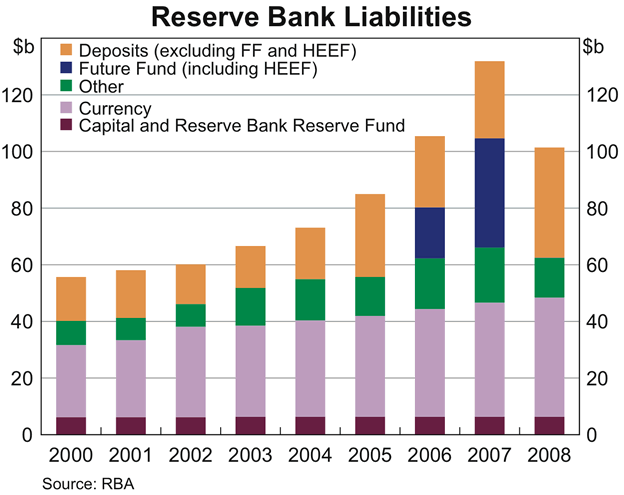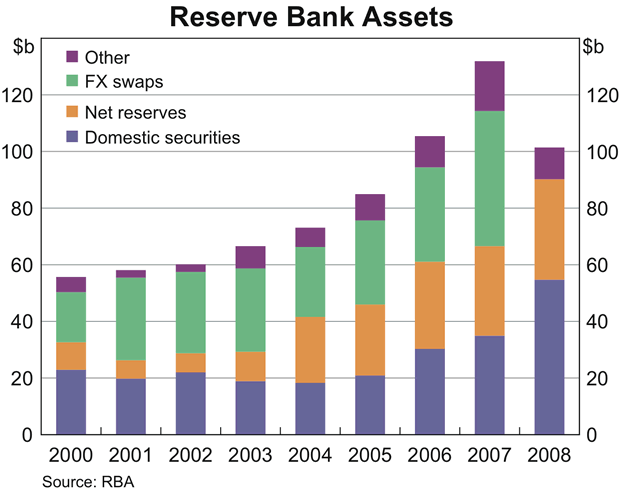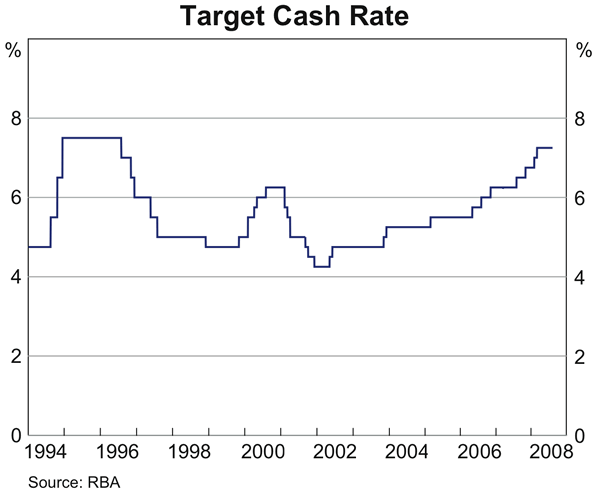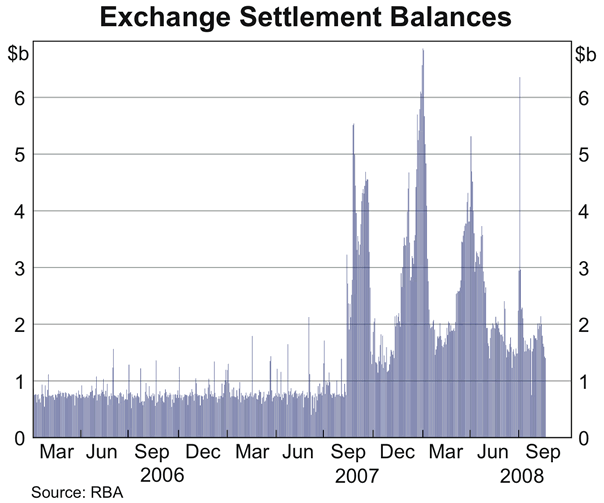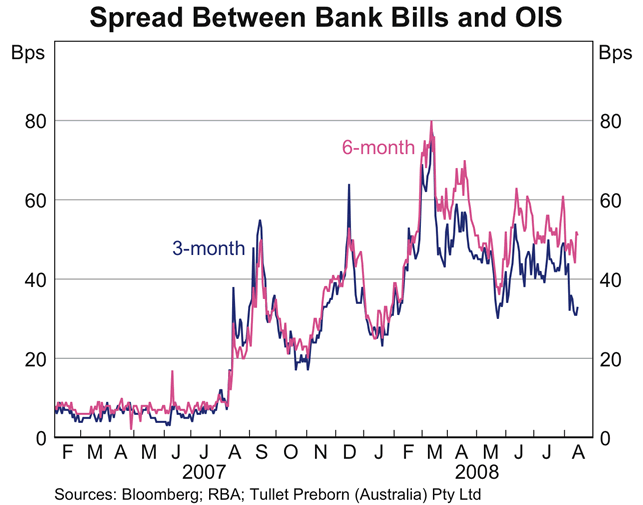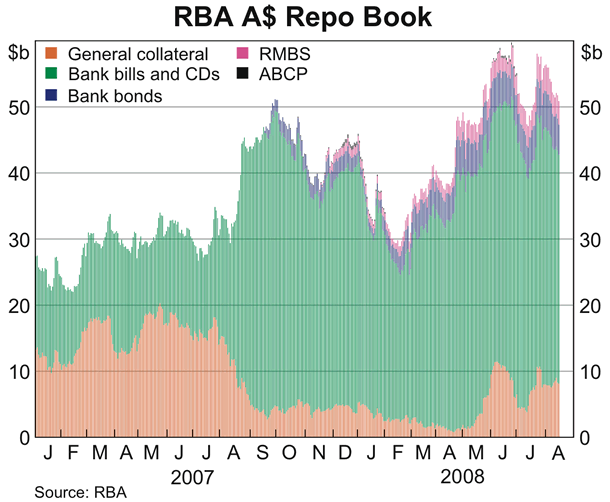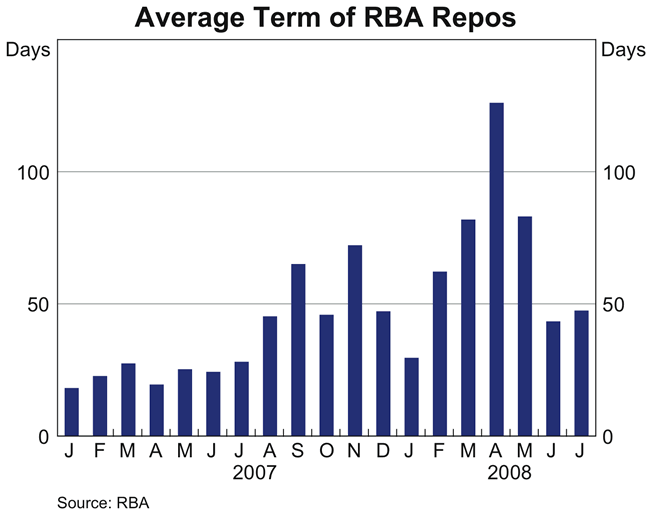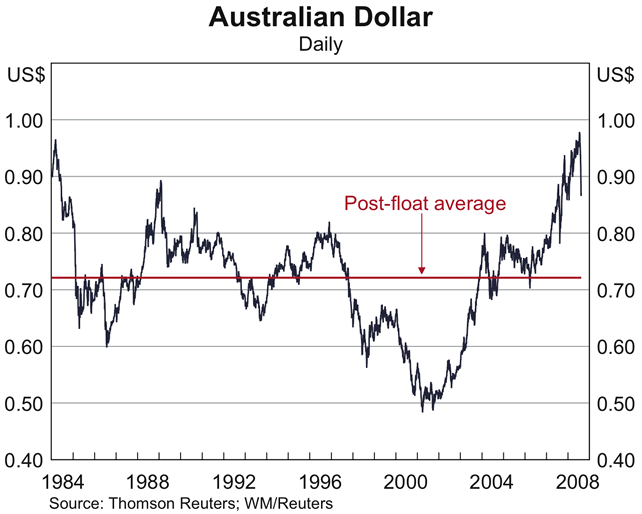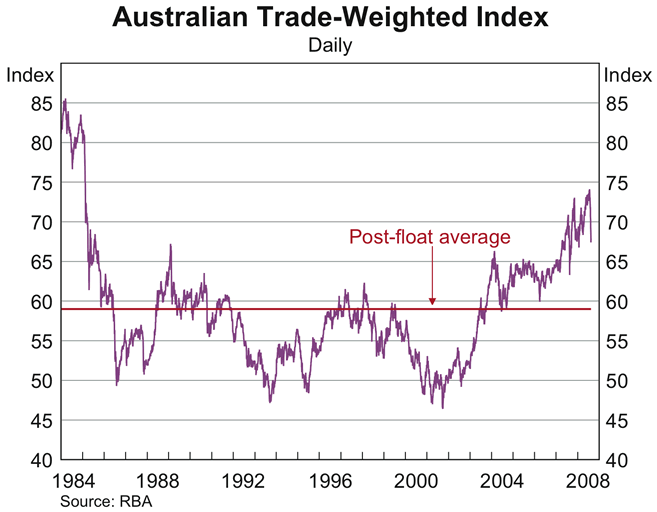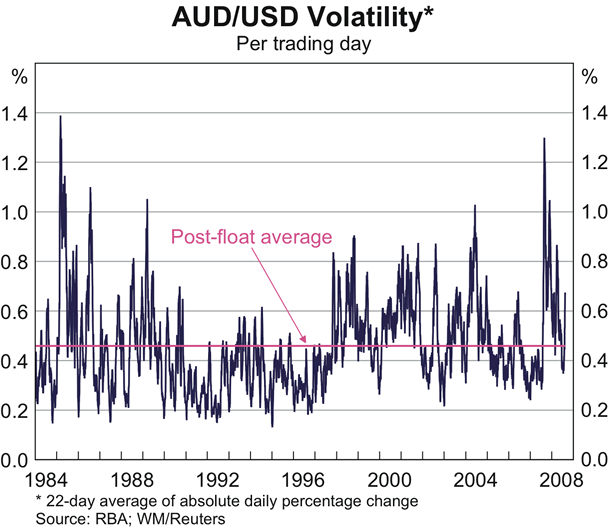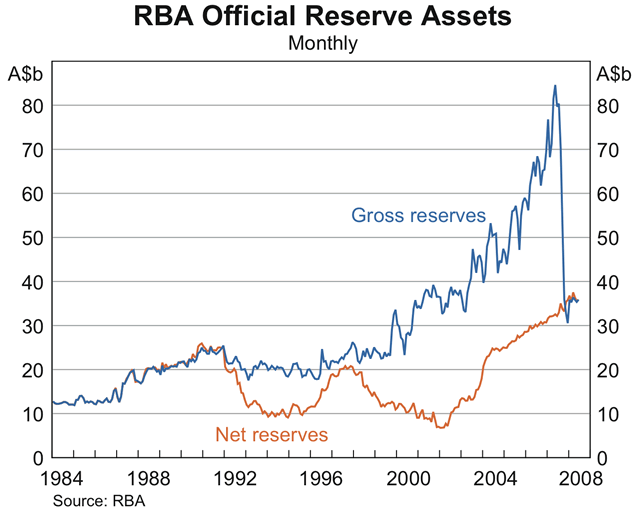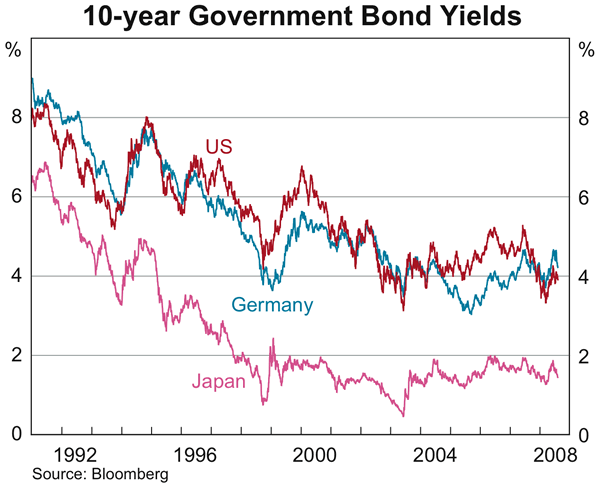Reserve Bank of Australia Annual Report – 2008 The Balance Sheet and Operations in Financial Markets
The primary reason the Reserve Bank operates in financial markets is to implement the Board's monetary policy decisions. However, the Bank also undertakes a large volume of transactions on behalf of its clients, particularly in the foreign exchange market, as well as on its own account to manage its balance sheet.
Over the past year, the size and composition of the Reserve Bank's balance sheet changed significantly. The balance sheet declined in size by $31 billion as a result of a reduction in deposits placed with the Bank by the Australian Government and its agencies, in particular the Future Fund. This, combined with policy decisions taken by the Bank in response to the global credit turmoil, had a material effect on the size and composition of its holdings of assets.
| June 2002 | June 2007 | June 2008 | |
|---|---|---|---|
| Assets | 60 | 132 | 101 |
| Foreign | 37 | 96 | 45 |
| – Net reserves(a) | 7 | 32 | 35 |
| – FX swaps | 29 | 48 | 0 |
| – Other | 1 | 16 | 10 |
| Domestic | 23 | 36 | 56 |
| Liabilities | 60 | 132 | 101 |
| Deposits | 14 | 66 | 39 |
| Currency | 32 | 40 | 42 |
| Other (including capital) | 14 | 26 | 20 |
| (a) Excludes Special Drawing Rights and Australiaís reserve position at the International Monetary Fund | |||
For a number of years there had been a substantial increase in the size of the balance sheet, reflecting the increase in government deposits as a result of ongoing budget surpluses. In 2006, some of these deposits were transferred in name to the Future Fund upon its establishment, while remaining on deposit at the Reserve Bank. Since June 2007, deposits held by the Future Fund have fallen by around $40 billion as the Fund withdrew most of its deposits and invested the funds in a broader range of assets. This movement in deposits was partially offset by an increase in government deposits held by the Australian Office of Financial Management (AOFM), reflecting the budget surplus in 2007/08, such that there was a net decline in deposits of $27 billion.
As these deposits, which are a liability of the Reserve Bank, were reduced, the Bank correspondingly ran down its asset holdings, primarily by reducing its holdings of foreign exchange held under swap. As noted in previous annual reports, the Bank had made extensive use of foreign exchange swaps in recent years to manage domestic liquidity as the balance sheet had grown.
At the same time, as is described in more detail below, the composition of the Reserve Bank's asset holdings also changed as a result of the Bank's response to the global credit turmoil. To ease tensions in the domestic money market, the Bank made increased use of repurchase agreements (repos) using domestic assets rather than foreign assets (in the form of foreign exchange swaps). The major increase was in the Bank's holdings of securities issued by authorised deposit-taking institutions (ADIs) acquired under repo, which rose from around 40 per cent of the Bank's portfolio of domestic securities to around three-quarters. In September and October 2007, the Bank also expanded the range of collateral eligible for open market operations, to include residential mortgage-backed securities (RMBS) and asset-backed commercial paper (ABCP). At end June 2008, RMBS and ABCP purchased under repo amounted to $3.3 billion, about 6 per cent of the domestic portfolio.
Over recent years, the Reserve Bank has reduced its reliance on Commonwealth Government securities (CGS) for domestic market operations, reflecting the shortage of such securities in the market. Over the past year, the Bank has sold virtually all of its remaining outright holdings of CGS as part of its market operations, to reduce its demands on the market, accommodating the sale through an expansion of the domestic repurchase book. The recent announcement by the Government that net issuance of CGS in 2008/09 and beyond is being increased is expected to promote some improvement in liquidity in this market.
Domestic Market Operations
The Reserve Bank Board implements monetary policy by setting a target for the cash rate – the interest rate on overnight unsecured loans in the interbank market. This rate affects interest rates in other wholesale and retail markets, which in turn affect economic activity and inflation.
The Board increased the target for the cash rate on four occasions in 2007/08, by increments of 25 basis points on each occasion. Since February 2008, the Board's decision on the cash rate target has been announced at 2.30 pm on the day of each Board meeting, with the target being effective from the next day. Previously, the outcomes of the Board's deliberations were announced on the day they became effective, usually the business day after the Board meeting.
Once the Board's decision on the target is announced, it is the responsibility of the Domestic Markets Department to ensure that the cash rate remains close to the target. The announcement of a change in monetary policy is normally sufficient in itself for the market to move the cash rate to the new target. Over time, however, the Reserve Bank needs to carry out transactions with the market, generally referred to as open market operations, to ensure the cash rate stays at this level. These transactions adjust the volume of exchange settlement (ES) balances held at the Bank. ES balances are the most immediate source of liquidity to banks and are used to meet their settlement obligations with each other and the Bank.
Payment flows between the Reserve Bank's customers and the private sector alter the aggregate amount of ES balances. The major customer of the Bank is the Australian Government. Most days, the Bank will act to offset the liquidity impact of these flows by purchasing (or, more rarely, selling) securities in its open market operations. The vast majority of these transactions are structured as repos, meaning that the counterparty transfers the title of the securities to the Reserve Bank in exchange for funds for the duration of the agreement. In 2007/08, the Bank conducted market operations on all but four business days, for a total of $304 billion.
The Reserve Bank remunerates ES balances at a rate 25 basis points below the cash rate target. This creates an incentive for account holders to recycle excess balances within the interbank market. As a result, the aggregate volume of ES balances is typically reasonably low – in recent years, it has usually been around $750 million.
Throughout much of 2007/08, however, market participants sought to maintain much higher ES balances as the functioning of global money markets became impaired, largely stemming from developments in the US sub-prime mortgage market. As banks all over the world became less certain of their own funding requirements and less confident of the credit profile of their counterparties, the interbank borrowing markets in most countries, including Australia, became quite tight as banks were more inclined to hold onto liquid balances. Although this was most evident in term markets, where borrowing rates increased sharply, the tightening of credit limits and the generally precautionary attitude meant there was a concern that ES funds would be more difficult to source. This resulted in increased demand for ES balances.
The Reserve Bank's initial response in August 2007 to this increased demand was to increase the supply of ES balances, from the level of around $750 million that had prevailed for a number of years, to more than $5 billion. If the Bank had not increased the supply, the cash rate would have risen above the target set by the Board as financial institutions bid more aggressively for funds in an attempt to increase their cash balances. Because of the framework for monetary operations, in particular the fact that the Bank deals in the market every day, the Bank was able very quickly to gauge the extent of the increased demand for cash and react accordingly.
As the demand for cash in the market ebbed and flowed throughout the past year, the Reserve Bank continued to vary the supply of ES balances. Since August 2007, ES balances have averaged almost $3 billion, peaking at $6.9 billion at the end of December 2007. ES balances have generally increased towards the end of calendar quarters, as institutions have sought to hold more liquid assets on their balance sheets through the quarter-end. This phenomenon had been evident prior to the credit turmoil, but has been accentuated over the past year. Reflecting the improved sentiment in financial markets from around mid March, ES balances tended to decline through the June quarter to around $1.5 billion.
As with many other central banks, the Reserve Bank responded to credit market developments by significantly altering the structure of its balance sheet and the nature of its transactions with the market. To a large degree, however, these changes were made within the Bank's existing operational framework.
As the strained market conditions continued into September 2007, the Reserve Bank, in addition to increasing ES balances, announced changes to the range of collateral that would be accepted at its open market operations. Other central banks also introduced changes to their operating frameworks around this time.
The range of eligible collateral for repurchase agreements with the Reserve Bank had been gradually expanded over the previous decade, prompted by the evolving nature of the debt markets in Australia. As the stock of CGS declined and the Reserve Bank's balance sheet grew, the Bank needed to accept other highly rated collateral from its counterparties. Securities issued by the borrowing authorities of State and Territory governments became eligible collateral in 1997, followed by AAA-rated Australian dollar debt of certain supranationals in 2000. The range of eligible securities was widened in 2004 to include bank bills and certificates of deposit issued by ADIs as well as Australian dollar debt of foreign government agencies, and from mid September 2007 the Bank began accepting highly rated ADI securities with a remaining term to maturity longer than 12 months as collateral on its repos. These securities are subject to minimum credit-rating requirements and margins as high as 9 per cent, compared with a margin of 2 per cent on repos secured by government securities or short-dated ADI paper.
With the market for securitised debt being particularly dislocated, the Reserve Bank announced that, from early October, RMBS and ABCP would also be eligible collateral. In addition to being of the highest credit quality (AAA-rated and P-1 rated, respectively), the Bank provides funds against these securities to the extent that at least 90 per cent of the assets backing them comprise prime ‘full-doc’ residential mortgages. Furthermore, a margin of at least 10 per cent is imposed. The RMBS and ABCP can be sponsored by both ADIs, namely banks, building societies and credit unions, as well as non‑ADIs. The securities are vetted by the Reserve Bank's Risk Management Unit before being deemed to be eligible collateral.
Separate from this day-to-day dealing, the Reserve Bank has been working with APRA and market participants to strengthen arrangements for dealing with extreme market disruptions. Reflecting that, both the Bank and APRA have encouraged ADIs to package residential mortgages they are retaining on their balance sheets into a securitised form as a means of accessing contingent financing from the Reserve Bank, if they were to experience serious funding difficulties. By end June, eight institutions had created these ‘self-securitised’ RMBS and several more were in the process of doing so.
When counterparties bid at the Reserve Bank's market operations, they are required to bid separately for repos backed by ‘general collateral’ (Commonwealth Government, semi-government and supranational securities), ADI paper, RMBS and ABCP. In this way, the Reserve Bank can more easily identify where pressures may be more intense in specific markets. It also means that the Bank retains control over the composition of its asset holdings.
Counterparties have always been prepared to pay a higher interest rate for repos secured by private paper than those secured against general collateral. During the period of market turmoil, when yields on private securities in the market rose sharply, institutions were able to purchase bank bills in the market and use them for collateral in repos with the Reserve Bank at a rate which, though higher than the rate on general collateral, was still cost effective. The Bank adjusted the structure of its repo portfolio in response to this shift in demand in a way that was designed to be helpful to the market for private debt securities. At various stages throughout 2007/08, as much as 90 per cent of the Bank's collateral holdings were in ADI paper, compared with an average of around 50 per cent over 2006/07. The increased holdings of these assets on the Bank's balance sheet helped to underpin the market in these securities while risk was being repriced. Investors could be confident that, while holding these assets, they would have access to a certain degree of liquidity should it be required.
In addition to changing the composition of its collateral as market conditions warranted, the Reserve Bank has also varied the maturity of its repo transactions quite significantly. Particularly at times when term markets for bank funding became highly stressed, the Bank signalled that it was willing to deal for longer terms so as to provide greater certainty of funding for counterparties and encourage liquidity in the underlying market for bank paper. In mid April 2008, the Bank nominated a preferred term of up to one year and accepted some approaches at that maturity, including in RMBS.
As noted above, the overriding purpose of the Reserve Bank's operations in financial markets is the implementation of monetary policy, namely maintaining conditions that keep the cash rate as close as possible to the Board's target. Throughout 2007/08, notwithstanding the large swings in the demand for cash, the cash rate target was met on all but 3 per cent of trading days, with the largest deviation being only 2 basis points. By international standards, this is a very small variation.
| Basis point deviations | ||||||
|---|---|---|---|---|---|---|
| −2 | −1 | 0 | 1 | 2 | 3 | |
| 2002/03 | 0 | 27 | 223 | 3 | 0 | 0 |
| 2003/04 | 0 | 0 | 250 | 5 | 0 | 0 |
| 2004/05 | 0 | 0 | 253 | 0 | 0 | 0 |
| 2005/06 | 0 | 0 | 253 | 0 | 0 | 0 |
| 2006/07 | 0 | 2 | 249 | 0 | 0 | 1 |
| 2007/08 | 1 | 8 | 244 | 0 | 0 | 0 |
In addition to its regular morning operations, the Reserve Bank is willing to conduct a second round of dealing with the market should liquidity conditions require it. In 2007/08, no second-round operations were conducted.
Individual ES account holders which face funding shortfalls are able to access a standing overnight facility with the Reserve Bank. Under this facility, banks can borrow funds on a secured basis at a rate 25 basis points above the cash rate. Generally, this facility is accessed only if banks encounter unexpected funding shortfalls late in the settlement session arising from operational constraints or forecasting errors. During 2007/08, the facility was used on 18 occasions for aggregate borrowings of $4.2 billion.
| Number of times used |
Value ($ million) |
|
|---|---|---|
| 2002/03 | 14 | 1,673 |
| 2003/04 | 24 | 2,159 |
| 2004/05 | 11 | 1,394 |
| 2005/06 | 10 | 436 |
| 2006/07 | 24 | 3,589 |
| 2007/08 | 18 | 4,220 |
Long-dated Liquidity Operations
As noted above, in its regular market operations the Reserve Bank generally undertakes transactions using repos. Although the Bank is willing to purchase CGS and semi-government securities on an outright basis in its daily operations, these transactions are restricted to debt securities having a maturity of 18 months or less. The Bank's outright purchases of longer-dated securities are contracted via separate operations that are carried out on a regular basis.
During 2007/08, the Reserve Bank conducted five long-dated operations, purchasing $550 million of securities, compared with six operations in the previous financial year. The value of long-dated semi-government securities held outright in the Bank's portfolio is currently around $2 billion. Sales of these securities in market operations provide another avenue by which the Bank may withdraw funds from the system to maintain the supply of ES balances in line with overall demand.
Securities Lending
The Reserve Bank lends CGS and semi-government securities that it holds on an outright basis on its balance sheet. These securities are lent to market participants via repos, with an offsetting reverse repo contracted with the same counterparty against ‘general collateral’. Income from securities lending amounted to $0.8 million in 2007/08.
In addition to lending securities from its own portfolio, the Reserve Bank operates a securities lending facility in CGS on behalf of the AOFM. This facility allows market participants to borrow any CGS on issue via repo with the Reserve Bank. An offsetting reverse repo in other CGS must also be undertaken, but at a margin of 300 basis points. In 2007/08, total lending through the facility was $2.5 billion, more than twice that in the previous financial year. In May 2008, the AOFM announced that the collateral eligible to be pledged in the offsetting repo would be broadened to include any general collateral (i.e. semi-government and supranational securities as well as CGS).
| Number of transactions |
Amount lent (face value, $ billion) |
Net income ($ million) |
|
|---|---|---|---|
| 2002/03 | 32 | 0.9 | 0.13 |
| 2003/04 | 185 | 5.0 | 0.5 |
| 2004/05 | 264 | 11.9 | 0.56 |
| 2005/06 | 460 | 20.3 | 0.89 |
| 2006/07 | 438 | 22.4 | 1.14 |
| 2007/08 | 243 | 13.8 | 0.82 |
Foreign Exchange Operations
The Reserve Bank operates in foreign exchange markets on behalf of its clients and on its own account. The Bank's client transactions in foreign exchange are dominated by transactions with the Australian Government. The Reserve Bank sells foreign currency to the Government to enable the latter to meet its foreign currency obligations, such as defence expenditure, foreign aid and embassy running costs. In 2007/08, the Bank sold $5 billion of foreign currency to the Government. As is typically the case, the Bank covered these sales by purchasing foreign currency in the market on its own account.
The Reserve Bank may operate in the foreign exchange market on its own account to influence the Australian dollar exchange rate, to assist domestic liquidity management and to manage its own holdings of foreign currency reserves. Transactions to influence the exchange rate or market conditions more generally, usually known as intervention, are relatively infrequent. They are undertaken only when the value of the Australian dollar is judged to have moved to levels that are inconsistent with underlying economic developments or when conditions in the foreign exchange market are thin and disorderly.
The Australian dollar continued to appreciate over the past year, reaching 25-year highs against the US dollar and 23-year highs on a trade-weighted basis in July 2008. The Reserve Bank viewed the appreciation as broadly consistent with developments in the Australian economy and the terms of trade. However, volatility in the Australian dollar increased sharply in the second half of 2007 in response to the developments in global credit markets and associated swings in investor risk appetite. In August 2007, a particularly sharp depreciation in the Australian dollar took place amid thin and disorderly conditions. To improve liquidity in the market at that time, the Reserve Bank sold a modest amount of foreign exchange and bought the Australian dollar. These transactions were not intended to influence the level of the exchange rate. This was the first intervention undertaken by the Bank since 2001.
As noted above, the Reserve Bank's holdings of foreign exchange swaps were run off over the second half of 2007. While small foreign exchange swap transactions were undertaken in the first half of 2008, the Bank ended the financial year with no net outstanding swap commitments. This rundown in holdings of foreign exchange under swaps meant that there was a sharp decline in gross foreign currency reserves over the second half of 2007. Gross reserves comprise both those held outright and those held under swap. Those held under swap entail an obligation to exchange the foreign currency back into Australian dollars (at a predetermined exchange rate) when the swap agreement matures. Net reserves, which are gross reserve assets excluding those held under foreign currency swaps, rose over the year as the Bank continued to add to reserves in a measured way with the Australian dollar around multi-year highs. Net purchases of reserves in the market and earnings on reserves totalled $4.5 billion in 2007/08, around the same as in 2006/07. The valuation effect of the appreciation of the Australian dollar against those currencies in which reserves are held had a small offsetting influence, such that the Australian dollar measure of net reserves rose by $3.7 billion over the year to $35.9 billion.
Reserves Management
The Reserve Bank holds gold and foreign currency reserve assets primarily to facilitate its intervention in the foreign exchange market. Given the role of the foreign currency reserves portfolio, the Bank places a high priority on holding assets that are liquid and of high credit quality. In practice, this means that a large portion of the portfolio is invested in government bonds issued by the United States, Germany, France and Japan. These securities are among the most liquid and most secure of all the financial market instruments available to the Bank.
Since the early 1990s, the Reserve Bank has invested its portfolio of reserves in line with its long-run benchmark. The benchmark represents the Bank's optimal long-run portfolio given its investment constraints. It has a currency and asset allocation of 45 per cent to the United States, 45 per cent to Europe and 10 per cent to Japan. Consideration is also given to the weighted average maturity, or duration, of the benchmark portfolio. Securities with longer duration are more sensitive to interest rate fluctuations. In order to manage this exposure, the Bank invests at an average duration of 30 months in each currency portfolio and limits the maturity of individual securities to 10.5 years. Since 2000, the portfolio management framework has allowed for only a very modest amount of discretion on the part of portfolio managers around the benchmark. In 2007/08, the actions resulting from this discretion generated an additional $83 million in returns.
| United States | Europe | Japan | |
|---|---|---|---|
| Asset allocation (% of total) | 45 | 45 | 10 |
| Currency allocation (% of total) | 45 | 45 | 10 |
| Duration (months) | 30 | 30 | 30 |
| Actual | Benchmark | Value of difference (A$ million) |
|
|---|---|---|---|
| 2001/02 | 3.9 | 3.7 | 63 |
| 2002/03 | 6.7 | 6.4 | 77 |
| 2003/04 | 0.5 | 0.3 | 67 |
| 2004/05 | 4.7 | 4.5 | 38 |
| 2005/06 | 1.2 | 1.0 | 55 |
| 2006/07 | 3.1 | 3.0 | 40 |
| 2007/08 | 6.5 | 6.2 | 83 |
Over 2007/08, the return on foreign currency assets, measured in SDRs, was 6.5 per cent, compared with a return of 3.1 per cent the previous year. However, the Australian dollar value of the return on reserves declined from $2.9 billion in 2006/07 to $2.3 billion in 2007/08. This largely reflected the fact that gross reserves were substantially lower because of the rundown in foreign exchange swaps noted above, as well as the valuation effect of the higher Australian dollar. Local currency returns were greater in the US and Japanese portfolios than in the previous year as the net decline in bond yields over the year led to capital gains on the Reserve Bank's holdings of bonds. The higher local currency return on the European portfolio reflected a smaller rise in bond yields than in the previous year.
As noted in last year's annual report, the Reserve Bank has continued to hold a small amount of its reserves in the Asian Bond Funds. The US dollar and local currency denominated Asian Bond Funds are an initiative of the EMEAP group, designed to expand investment opportunities and promote bond markets in the region. The amount invested in both the US dollar denominated bond and local currency denominated bond funds is currently $343 million, down from $371 million in 2006/07. The fall reflects the rise in the value of the Australian dollar. The return over 2007/08 in US dollar terms was 4.6 per cent.
As part of its official reserves assets, the Reserve Bank also holds about 80 tonnes of gold. Over 2007/08, gold prices rose by around 43 per cent in US dollar terms and by around 26 per cent in Australian dollar terms. As a result, the Bank's gold holdings rose in value by about $0.5 billion to around $2.5 billion.
The Reserve Bank offers to lend its gold holdings against quality collateral to major participants in the gold market. However, interest from the market to borrow gold was minimal over the course of 2007/08, with gold leasing rates at very low levels. Reflecting this, the Bank continued to take delivery of maturing gold loans and the total amount of gold on loan declined to 27 tonnes, from 42 tonnes at end June 2007. The income generated from gold lending also declined, to $8.3 million from $11.0 million in the previous year.
| United States | Europe | Japan | |
|---|---|---|---|
| 2001/02 | 6.1 | 4.7 | 0.4 |
| 2002/03 | 6.6 | 7.2 | 1.3 |
| 2003/04 | 0 | 1.9 | 0 |
| 2004/05 | 4.1 | 5.8 | 1.1 |
| 2005/06 | 1.2 | 0.1 | −0.9 |
| 2006/07 | 5.6 | 2.2 | 1.1 |
| 2007/08 | 8.1 | 4.0 | 1.7 |
